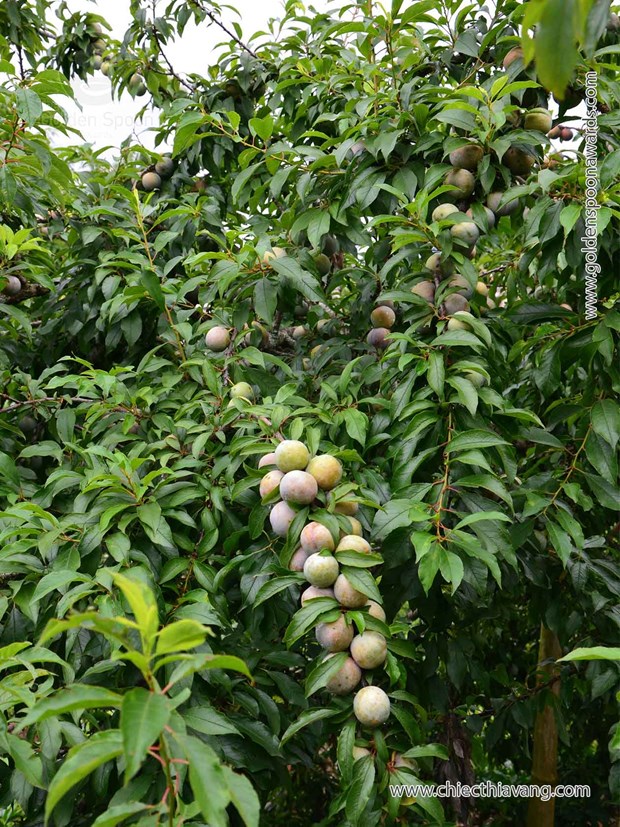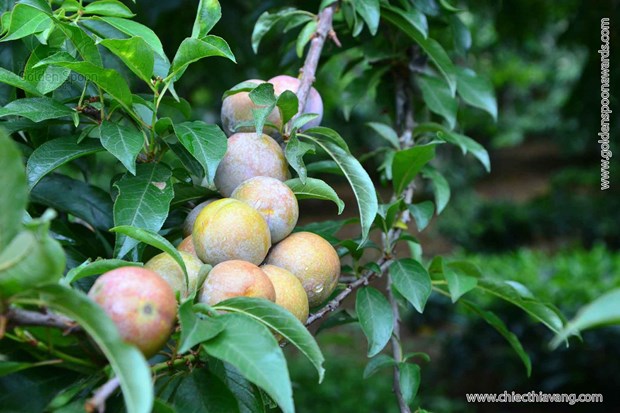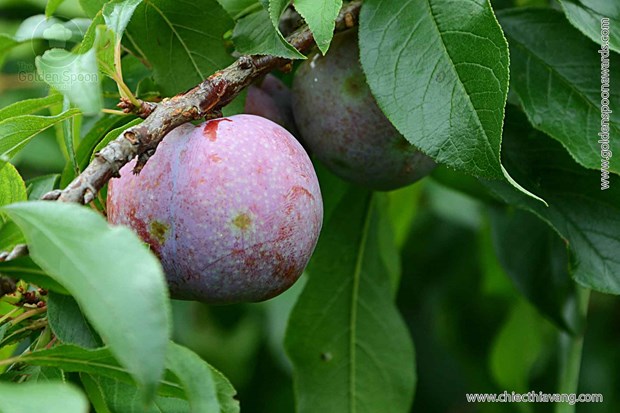The beginning of summer is when plums are bearing all over Northern highlands of Vietnam. Because of harsher climate, Northern fruits are not as diverse and as the South’s but it does not mean quality of those is much different.

The plum tree with its fruits in the mountainous town of Nông Trường, Mộc Châu, Sơn La Province.
Northern
highlands in Vietnam have a separate climate from the south, including enough 4
seasons in a year, in which winter is long and cold while summer is really hot.
Therefore, temperate plants can grow here, such as peaches, nectarines,
apricots, and plums – which never can grow in the tropical south.
So-called
plums in the North are quite diverse and the most popular types are red plums
(3 flowers plums and Hậu plums),
besides there are prunes (European plums) and greengage plums in Tả Van and Tả
Hoàng Ly (Bắc Hà, Lào Cai), and green prunes (Lạng Sơn). Bắc Hà (Lào Cai
province) is the capital and like “ground zero” of plum trees in Vietnam.
Around 2 decades ago, this type of temperate trees was brought to Mộc Châu, Sơn
La province. Although coming late, plum trees in Mộc Châu were zoned into
orchards with tea trees intercropping, which came out a much better result.
Plum trees have suited climate and soils in Sơn La province and that advantage
have made a huge difference in shape and quality of Mộc Châu plums from other
plums. Moreover, Mộc Châu is close to Hà Nội capital with better and more
convenient transportation so that almost trading plums all over Vietnam are
from Mộc Châu.

A branch with ripening plums.
When
April comes to the end, apricot season is over and plums have just come. Mộc Châu
plums have a firm and fibrous texture, a natural wax layer on their
pinky-yellowish skin and ripe fruits get dark red to purple inside out. This
type of plums tastes still a bit sour, even when they’re ripe. Only when the
whole fruit are really ripe to soft, the taste turns completely sweet.
Not
only good tasting, red plums are also a natural medicine with multi-effects.
Anti-cancer
Red
plums contain much anthocyanin – an anti-oxidant supplement can neutralize
oxygen radicals that cause cancer. Vitamin C and fiber support digestive system
and usefully prevent colon cancer.
Reduce cholesterol
absorption
High
vitamin C content of red plums prevents cholesterol from oxidizing in the
arteries, eliminating bad cholesterol from the body.
As
a result, eating plum can prevent atherosclerosis, osteoarthritis, rheumatoid
arthritis, and asthma.
Good for
cardiovascular system
Red
plums are rich in Kali that helps adjust blood pressure and dramatically reduce
the risk of stroke.
Enhances iron
absorption
High
vitamin C content in plums is the basis to help our body to effectively absorb
iron and to increase the ability of fighting disease and infection of the body.
Laxative supplement
Red
plums carry lots of fiber, isatin, and sorbitol, which are extremely good
substances for the digestive system, regulating the function of this internal
organs. Eating plum helps to regulate bowel movement, reduce the risk of
constipation.
Many
people treat constipation by eating dried prunes or fresh plums.

Fully ripe hau plums.
Rich source for eyes
Besides
vitamin C, red plums also carry beta-carotene, which are nutrition of eyes.
Eating plums can help reduce the risk of developing macular degeneration, an
eye disease that can lead to blindness.
Recently,
only in Mộc Châu ward there are over 1,800 hectare of plum orchards with
capacity up to 25,000 tons per year (data from 2010). To avoid devaluation as
other typical agricultural produce, Mộc Châu ward has turned red plums to a
year-round specialty. They produce dried whole and dried pitted plums, plum
candies and pickled plums in mass, and plum wine with much longer shelf-life
and easier to transport.
When
the season starts, the price of red plums could go up to $5.00 per kilogram but
it downs to $1.00 - $2.00 per kilograms in peak season with better quality.
Plums’ aroma and flavors are too mouthwatering for women to resist. Besides
eating fresh plums with hot pepper salt, plum syrup is a delicious and healthy
drink that anyone can do it.
* PLUM SYRUP
INSTRUCTION:
Ingredient:
-
2kg ripe plums
-
1.5kg white sugar
Instruction:
-
Wash plums and drain; cut around the fruit and lightly squeeze the two halves
to open it up; take the seed out.
-
Glass containers should be clean and dried ahead. Place plums and white sugar
in to containers, layer by layer. Cover the last layer with the rest of sugar.
-
Cover. Store containers in cool airy places about 5 days (until sugar are
dissolved).
-
Serve plum syrup with ice.
By Thu Pham